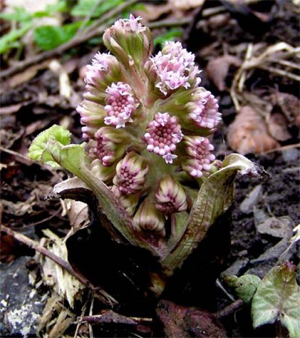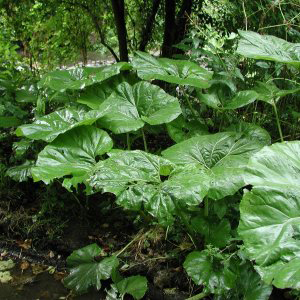Contents:
Common Names | Parts Usually Used | Plant(s) & Culture | Where Found | Medicinal Properties
Legends, Myths and Stories | Uses | How Sold | Bibliography
Scientific Names

- Petasites vulgaris L.
- Compositae
- Composite family
Common Names
- Petasites
Parts Usually Used
Root
Back to Top

Description of Plant(s) and Culture
Butterbur is a thick-stalked perennial plant that appears in early spring. A little later come the flowers, preceding the leaves and gathered in dense pinkish clusters. Bees love them for their nectar. The leaves themselves are kidney-shaped, rough toothed and large, their undersides are white. The lower part being divided into 2 round parts, close almost together, pale green and hairy underneath. The root is long, and spreads under the ground, being in some places no bigger than ones finger, in others much bigger, blackish on the outside, and whitish inside. The taste is bitter and unpleasant. The flower blooms and decays in February and March before the leaves appear in April.
Back to Top
Where Found
Grow in low wet grounds by rivers and water sides
Back to Top
Medicinal Properties
Tonic, cardiac, diuretic, anticarcinogenic
Back to Top
Legends, Myths and Stories
Butterbur is quite harmless and non-poisonous. But the tincture may be too strong for some people. If unusual symptoms occur, reduce the dosage or dilute the dosage and the symptoms will disappear.
Back to Top
Uses
A general tonic, stimulating the heart and kidneys. Reduces tumors, even cancers, so it is claimed. Has been used to treat depression, dropsy, obesity, Hodgkin’s disease, plague, fevers, kills flat and broad worms, increases urine output, sores that are hard to cure, asthma, migraine, menstrual cramps, spasms, and cures addiction to pain-killing drugs.
No known side-effects, even in large doses over a long period of time.
Back to Top
How Sold
Tablet form, known as Petadolor
Petaforce capsules
Petaforce is a harmless, non-toxic plant remedy to help cancer patients, even if they are on chemotherapy. Petaforce alleviates the unbearable pain suffered by cancer patients in the advanced stage of the illness, when morphine injections begin to fail. The Nature Doctor states that it reduces the danger of metastasis, improves the patient’s condition and prospects of a cure, and makes the existing pain more endurable.
Back to Top
Bibliography
![]() Culpeper’s Complete Herbal & English Physician: Updated With 117 Modern Herbs
Culpeper’s Complete Herbal & English Physician: Updated With 117 Modern Herbs, by Nicholas Culpeper, Meyerbooks, publisher, PO Box 427, Glenwood, Illinois 60425, 1990, (reprint of 1814)
 The Magic of Herbs
The Magic of Herbs, by David Conway, published by Jonathan Cape, Thirty Bedford Square, London, England. (Out of print)
![]() The Nature Doctor: A Manual of Traditional and Complementary Medicine
The Nature Doctor: A Manual of Traditional and Complementary Medicine, by Dr. H.C.A. Vogel; Keats Publishing, Inc., 27 Pine Street (Box 876) New Canaan, CT. 06840-0876. Copyright Verlag A. Vogel, Teufen (AR) Switzerland 1952, 1991
![]() Webster’s New World Dictionary
Webster’s New World Dictionary, Third College Edition, Victoria Neufeldt, Editor in Chief, New World Dictionaries: A Division of Simon & Schuster, Inc., 15 Columbus Circle, New York, NY 10023
